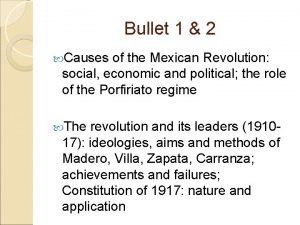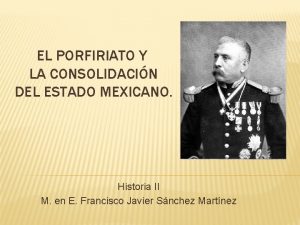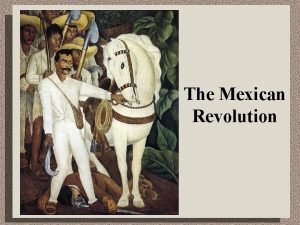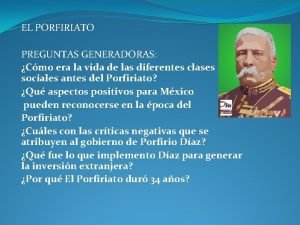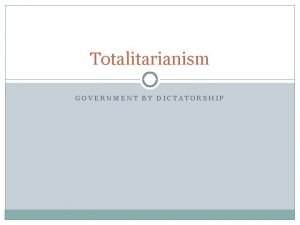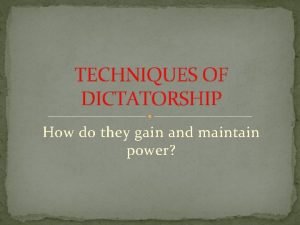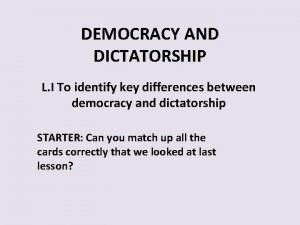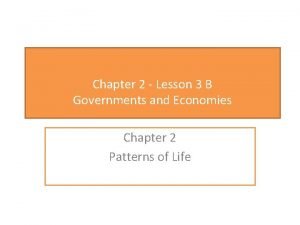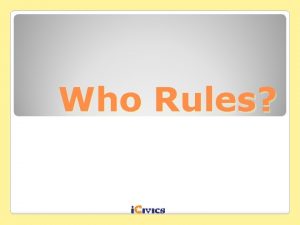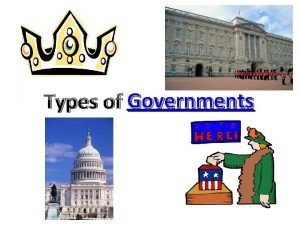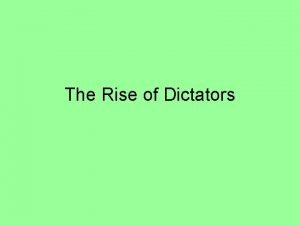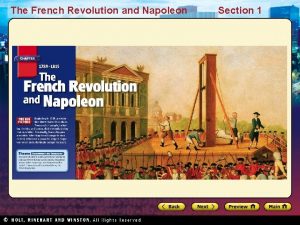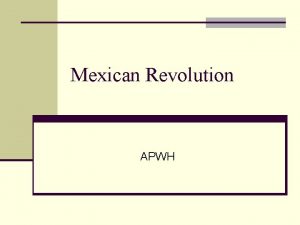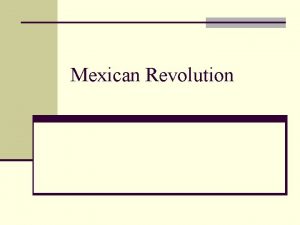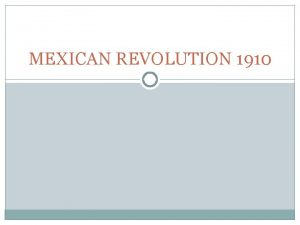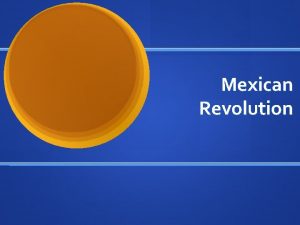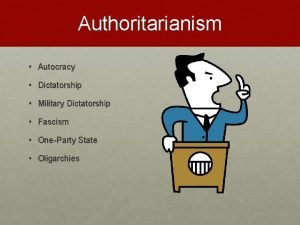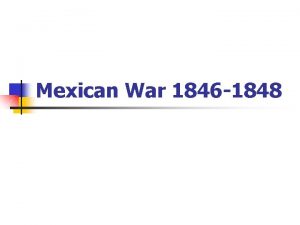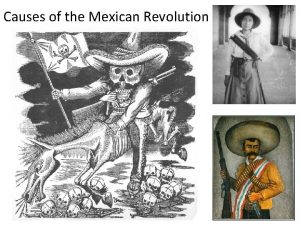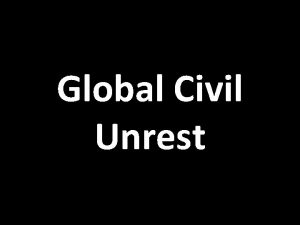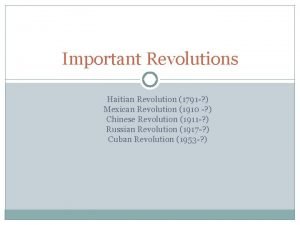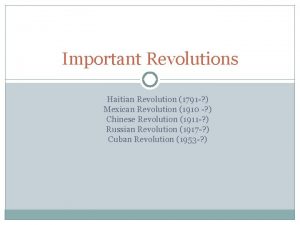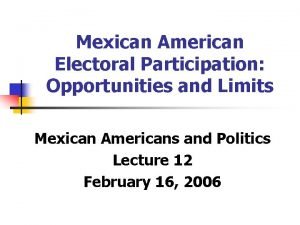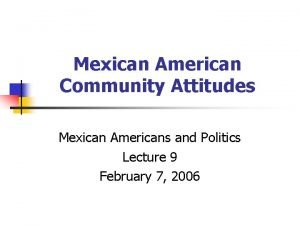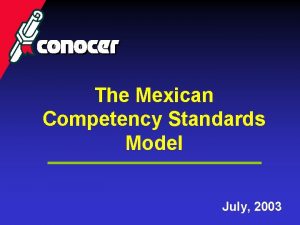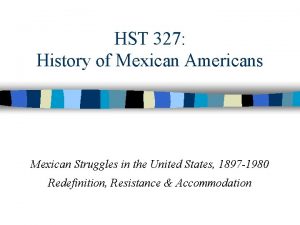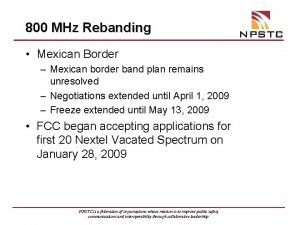Causes of the Mexican Revolution Dictatorship of Porfirio
























- Slides: 24

Causes of the Mexican Revolution

Dictatorship of Porfirio Diaz – Efficient Regime • Diaz’s regime was a highly centralized and efficient dictatorship • Patronage linked all institutions that might seriously challenge his rule – Local oligarchies – Army – Church – Merchants and urban professional classes • Everyone else he had killed

Dictatorship of Porfirio Diaz – Suppression of Rights • • • Was not totalitarian or a police state because he lacked the technology Was the rurales – a quasi-military mounted police force that patrolled the countryside Opposition was branded criminals and the crime was to be worked to death on chain-gangs or sent to plantations in the extreme south of Mexico Abolished the right to jury trial for journalists, but paid out generous subsidies to editors who gave new as he wanted it reported There were few revolts during his regime because of the terrifying consequences

Dictatorship of Porfirio Diaz – Maintaining Power • • • Believed in supporting a state governor against the local military leader until the government had won. Then he could change and build up the military leader again as a counterweight so that the governor was not too powerful He maintained an official stance of anticlericalism while secretly colluding with the Church. The Church could own property, but had to submit all appointments to Diaz for his approval He would support the haciendados against the villagers until the villagers became so upset that he had to make some concessions, but then would collaborate with the haciendados again

Dictatorship of Porfirio Diaz – Improvements • He made improvements to the: – – – • • Water supply Street lighting Railway terminal Telephone and telegraph offices Postal offices However, all this was a façade, as large numbers of people were either working class, unemployed, or underemployed The levels of literacy, political awareness, and education were abysmal

Causes of the Mexican Revolution – Rise of the Working Class • Americans owned ¾ of the mines and more than half the oil fields They also had companies for: • – – – • Sugar Coffee Cotton Rubber Cattle Foreign investment was giving rise to an urban working class, which was not so easily dealt with as the peasantry because they could band together and strike

Causes of the Mexican Revolution – Rise of the Working Class/Cananea • • In 1906, facing falling production, management in the Cananea copper mine changed wage scales and conditions of service, so workers went on strike Demonstrators rushed the building; armed Americans inside fired on them and killed two men; in retaliation the enraged strikers then burned down the building, killing four Americans in the blaze The strikers got firearms and had a gunfight with management in which there were 13 more deaths Arizona Rangers were called in to help

Causes of the Mexican Revolution – Rise of the Working Class/Cananea • Diaz lost much support through the bloody repression of this outburst and it showed that the Mexican economy was less solid than the ceintificos (business) thought • Rising prices and declining wages in the years 1907 -10 meant that if ever Diaz did come under serious threat, fewer and fewer people would step up to save him

Causes of the Mexican Revolution – Land Problems • • • The government stripped the Indians of their lands, which provided a bonanza for speculators Foreign real estate corporations were particularly predatory when it came to buying up or simply stealing land that formerly belonged to Indians Land was concentrated in fewer and fewer hands, especially after 1894 when the legal limits on ownership by any one individual were lifted

Causes of the Mexican Revolution – Land Problems • The hacienda encroached on village lands that most had enjoyed for centuries through customary right and had not filed documentary title • Hacendados controlled the state courts and dominated local politics, making local democracy or free elections impossible • If villagers lost their lands to the haciendas, they would face starvation unless they became a part of the haciendas • Diaz couldn’t curtail the privileges of the landlord because they were the people on whom he relied to stay in power

Causes of the Mexican Revolution – Hacienda System • Diaz’s attempt to impose a capitalist revolution was impossible because the power of the landlord and hacendado class Its labor repressive agricultural methods and in particular the institution of peonage all worked to impair the efficiency of the market. Peons had to: • – – Work all day Were at the mercy of brutal overseers Had to buy all needs at the company store, where debts were run up Debts were made heritable, so peonage became slavery

Causes of the Mexican Revolution – Corruption • Most corrupt and incompetent was the rurales – – – • Used summary justice by shooting prisoners Nepotism (favoritism to relatives) was rife Discipline lax Were lazy Officers were illiterate Behaved as petty despots The caliber of their recruitment declined because of all this

Causes of the Mexican Revolution – Succession • • • Diaz tried to prove himself a figure of consummate statesmanship: he said that he would like to see the emergence of an opposition party now that he had guided Mexico into an era when it was ready for democracy To prove his seriousness, he was ready to state here and now that he would not be a candidate in the 1910 presidential election Naturally he had no intention of keeping his word and duly had himself reelected when 1910 came round, but the opposition immediately manifested itself

Causes of the Mexican Revolution – Succession • Wrote and sold “The Presidential Succession of 1910”, which sold out immediately – – • The diagnosis was that absolute power in one man was always bad and harmful consequences The cure prescribed by Madero was a simple return to the Constitution of 1857, fair and valid voting, and no reelection He formed the Anti-Reelection Party and was nominated as presidential candidate

Causes of the Mexican Revolution – Succession • Madero met with Diaz, but was convinced by his meeting that peaceful change was impossible. He believed that only a revolution could shift the dictator and warned that force would be met with force • Diaz now ordered a purge of the new party. After more than 6, 000 arrests of the leading lights, the smaller fry went into hiding and Diaz was left free to fix voting turnout figures and intimidate the electorate • Diaz had been reelected by a record margin

Causes of the Mexican Revolution – Succession • On Oct. 4, 1910, Madero jumped bail and was smuggled across to Laredo In San Antonio, Texas, in late October, he issued the Plan of San Luis Potosi, which proclaimed: • – – The elections of 1910 null and void Declared that he was the real president of Mexico Called on all Mexicans to refuse obedience to Diaz Called for armed revolution and specified that it was to break out on Nov. 20, 1910 at 6 pm

Aims of Francisco Madero • He wanted limited political and social reforms • The major reform that he wanted was fair voting and no presidential reelection • He also was an advocate for land reform, capitalism, and education

Why Madero’s Aims Failed • Mexico had many problems, but failed to address them • He wasn’t as truly revolutionary as people thought he was going to be, so he lost support – He failed to address land reform, which lost him the trust and support of the peasants, especially Zapata – He upset Villa by not making the promised reforms and favoring Huerta • He followed the constitution and allowed Diaz’s cronies to stay in power until the end of their term – The judges (hacendados) were left in power – Diaz’s army leaders were left in power

Why Madero’s Aims Failed • He couldn’t make reforms because he would upset the rich, who kept him in power • Was guilty of nepotism • Wanted to make the country a democracy, but didn’t address the masses’ concern of food and land • Wanted political stability before land reform

Aims of Emilio Zapata • Led a rebellion of landless peasants and sought the return of the land of the haciendas to the landless peasants Plan of Ayala (1911) • – Issued on the premise that peaceful change was an illusion The Plan called for: – • • The restitution of lands seized by hacendados Expropriation of 1/3 of all large estates If there was armed resistance by landowners, the remaining 2/3 would be expropriated to pay for war indemnities and widows’ pensions Big advocate of education

Aims of Poncho Villa • Remembered the unfair economic abuses of hacienda owners and would make changes, including: – A bank which would make low interest loans to farmers. This allowed them to buy equipment and seeds for their fields and not have a huge debt burdened on them – Restore village lands – Pay taxes left unpaid by the hacendados – Establish schools • He envisioned the entire country divided into military colonies, in which men would work for three days and spend another three days on military training • Concerned with unemployment, economic hardship, taxation, conscription, and press-gangs

To What Extent Were Their Aims Not Realized? • • Failed to lead a national revolution because their aims appealed to not all groups The lot of the mass of people were scarcely improved Most of the old landowning aristocracy never returned to their pre-1910 positions of power and influence, but new elites took their place Constitution of 1917 – – – Increased the power of the presidency Abolished the office of vice-president Weakened the legislature

To What Extent Were Their Aims Realized? • Constitution of 1917 – Land Reform – – – Declared that private property was not an absolute right, but one that could be revoked, as the ultimate owner of land, water, and subsoil rights was the nation Any land illegally taken from villages by local officials or state governors is to be returned Centers of population which lack communal lands (ejidos) or which are unable to have them restored to them due to lack of titles, impossibility of identification, or because they had been legally transferred, shall be granted sufficient lands and waters to constitute them, in accordance with the needs of the population

To What Extent Were Their Aims Realized? • • No presidential succession Slavery is illegal Zapata Villa Elementary education is compulsory and free Today: – – Constitution of 1917 still governs the country Mexico is a democracy Ejidos make up ½ the farmland of Mexico today Zapatista Liberation Army is a terrorist organization based of Emiliano Zapata
 What were the causes of the mexican revolution
What were the causes of the mexican revolution Quién fue porfirio díaz
Quién fue porfirio díaz Dialogo della natura e di un islandese
Dialogo della natura e di un islandese Porfirio diaz daughter
Porfirio diaz daughter 10 preguntas del porfiriato
10 preguntas del porfiriato árvore de porfírio
árvore de porfírio Como agua para chocolate mexican revolution
Como agua para chocolate mexican revolution Pros and cons of totalitarianism
Pros and cons of totalitarianism Techniques of dictatorship
Techniques of dictatorship Dubai dictatorship
Dubai dictatorship Totalitarianism vs democracy venn diagram
Totalitarianism vs democracy venn diagram Dictatorship
Dictatorship Difference between monarchy and dictatorship
Difference between monarchy and dictatorship Dictatorship chapter 33
Dictatorship chapter 33 Dictatorship
Dictatorship Forms of government
Forms of government Constitutional monarchy pros and cons
Constitutional monarchy pros and cons Dictators threaten world peace
Dictators threaten world peace Proximate vs ultimate causation
Proximate vs ultimate causation Social behavior examples in animals
Social behavior examples in animals French revolution
French revolution The effects of the french revolution
The effects of the french revolution 5 causes of the french revolution
5 causes of the french revolution Why do we have seasons
Why do we have seasons Three causes of french revolution
Three causes of french revolution
